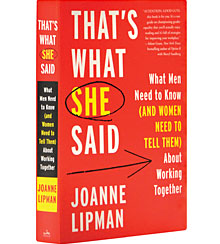Minding the Gender Gap
In her book on gender disparity in the workplace, journalist Joanne Lipman challenges men and women to overcome unconscious bias. See also “Summer Reading: 8 Business Books – in Pictures”
A version of this article appeared in the Summer 2018 issue of strategy+business.
That’s What She Said: What Men Need to Know (and Women Need to Tell Them) about Working Together
by Joanne Lipman, William Morrow, 2018
At the beginning of That’s What She Said, an engaging and astute book on the many structural and behavioral challenges women face at work, Joanne Lipman promises her male audience that there will be no ranting, finger pointing, or naming and shaming. So she starts slowly, by describing how the world around us is unconsciously designed for men, by men. A former editor of USA Today, deputy editor at the Wall Street Journal, and editor-in-chief of Portfolio, Lipman marries a good eye for anecdotes with a reverence for facts. Take, for example, the temperature in most office buildings: Apparently, it is set to accommodate male metabolic rates, which is why women often feel chilly. Seat belts are designed to protect male bodies, which means women are 47 percent more likely to sustain injuries in a crash.
The problem, as Lipman presents it, is that men have not been challenged often enough to see the world through any lens but that of their own making. She cites studies and surveys that show men believe they are smarter than they actually are; and that they consistently pick male job candidates over female candidates even if the resumes are the same because they believe men are smarter than women. In technology, where the problem is most acute, she cites data that shows men will prefer coding done by men even if blind tests show women do a better job.
The first half of the book, which the publisher bills as Lean In meets Freakonomics, examines the behaviors of both men and women that help perpetuate the gender gap, from almost-routine sexism to women’s general reticence about self-promotion. There’s the tale from the 1950s of Earl Tupper and his business partner Brownie Wise: Tupper did indeed invent the plastic storage ware that would bear his name, but it was Wise who developed the network of homemaker saleswomen who turned Tupperware into a business and made Tupper rich. When Wise appeared on the cover of Business Week in 1954, Tupper fired her for taking too much credit.
But we live in a different age now, right? Lipman cites recent research that shows men’s self-esteem takes a hit when their female partners do better than they do on problem-solving tests. We all find it hard to escape unconscious bias. One study showed that simply using a male name instead of a female name on a resume for a lab assistant gave the applicant a greater chance at success and a higher salary. (One small criticism of the book is that although much of the data cited is from academic research, some is not, and it is often hard to tell the difference.)
The second half of the book is more concentrated on solutions, particularly involving the issue of unconscious bias. There’s no easy way to counter this. Lipman attended an anti-bias training offered by Facebook, which sharpened her “making assumptions” awareness, but even she seemed unconvinced it would stick. She visited the Manbassadors student group at Harvard Business School, started in 2013 to highlight the issue of gender equity on the male-dominated campus. One of its founders told Lipman that after taking a job, she didn’t mention her involvement with Manbassadors “because it could be off-putting to my coworkers.”
The temperature in most office buildings apparently is set to accommodate male metabolic rates, which is why women often feel chilly.
In her chapter “Blind Auditions,” Lipman, whose previous book, Strings Attached, was a memoir of her years as a viola student, hits on what seems a better approach than anti-bias training. After it started to audition players from behind a curtain in the 1980s, the Chicago Symphony Orchestra was transformed from a male-dominated group to an equal-opportunity employer. The Vienna Philharmonic, which only recently started auditioning blind, remains overwhelmingly male. Google has introduced “bias cheat sheets” for its employees’ performance reviews; one pointed out the perils of the “horns and halo effects” in which snap judgments about either bad qualities (horns) or good qualities (halos) cloud the assessment of actual performance. But Lipman reports that it was a change in employment terms, based on real incentives, that significantly helped Google narrow the gender gap: When the company improved its family leave policy in 2011, the attrition rates for women who had children dropped 50 percent.
It would have been interesting to hear more about the role of incentives in leveling the playing field. What if C-suite bonuses were based on meeting diversity goals instead of earnings-per-share goals? Or if mentors’ advancement was linked to that of their mentees? But that is not really Lipman’s goal. She’s focused on fairness. Through data and anecdotal evidence, Lipman has shown just how unfair the world of work is to women. At the end of the book, Lipman gives a few suggestions that might help men to redress the balance. Although in keeping with the understated tone of the book, it seems a rather lame finale. There’s a plea for men to respect women, to avoid over-talking or giving inappropriate compliments, to amplify the success of women, to have more blind auditions and proper sponsorship, and to not be put off by the expression of emotions.
I hope this polite invitation to men to “join the conversation, to work together to close the gender gap” does catch male readers. Men will learn a great deal from this book, as will women, that might lead both sexes to change their behavior. My fear is that men might agree with the title of chapter 4, that the 12 most terrifying words in the English language (a definition lifted from the Economist) are “I’m from human resources and I’m here to organize a diversity workshop” — and slam the book shut. That would be disappointing.
There is one final choice that confused me. The U.S. title is convoluted, and is illustrated on the cover with arrows and colors. It is a visual equivalent of multitasking that, as Lipman knows from her research, is best interpreted by a female brain. Women will easily get it. The U.K. title is more direct: Win Win: When Business Works for Women, It Works for Everyone. Bam. Men will get this. Perhaps the U.S. publisher has missed a trick.




